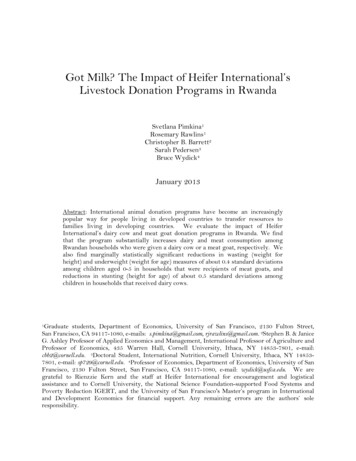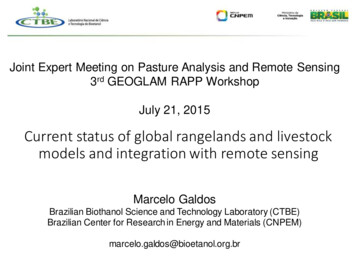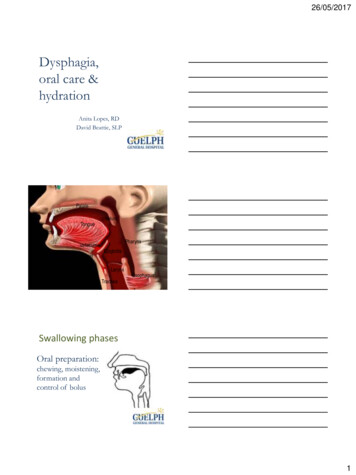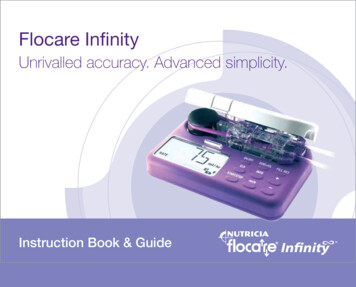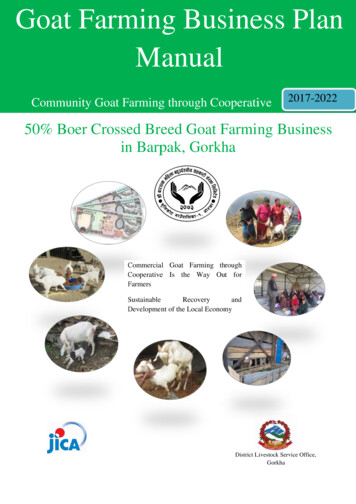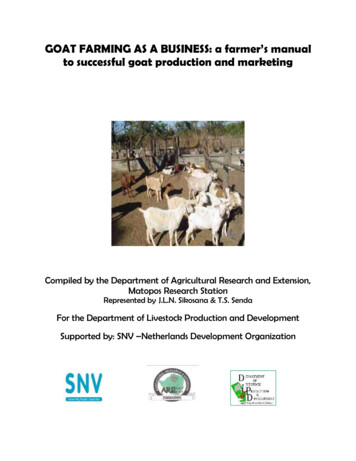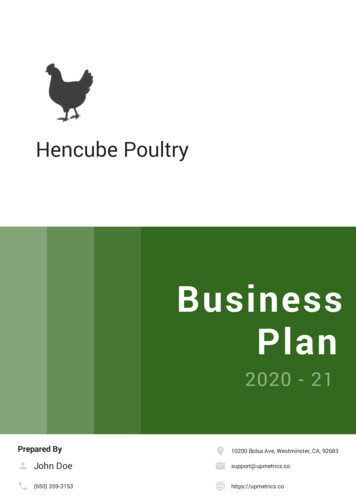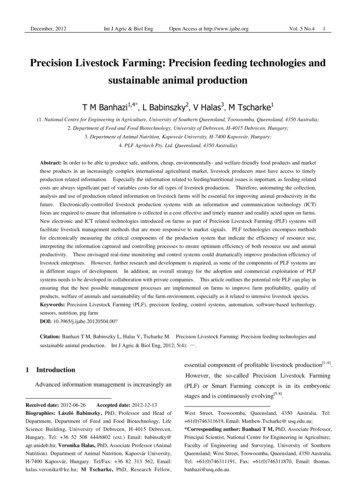
Transcription
December, 2012Int J Agric & Biol EngOpen Access at http://www.ijabe.orgVol. 5 No.41Precision Livestock Farming: Precision feeding technologies andsustainable animal productionT M Banhazi1,4*, L Babinszky2, V Halas3, M Tscharke1(1. National Centre for Engineering in Agriculture, University of Southern Queensland, Toowoomba, Queensland, 4350 Australia;2. Department of Feed and Food Biotechnology, University of Debrecen, H-4015 Debrecen, Hungary;3. Department of Animal Nutrition, Kaposvár University, H-7400 Kaposvár, Hungary;4. PLF Agritech Pty. Ltd. Queensland, 4350 Australia)Abstract: In order to be able to produce safe, uniform, cheap, environmentally- and welfare-friendly food products and marketthese products in an increasingly complex international agricultural market, livestock producers must have access to timelyproduction related information.Especially the information related to feeding/nutritional issues is important, as feeding relatedcosts are always significant part of variables costs for all types of livestock production.Therefore, automating the collection,analysis and use of production related information on livestock farms will be essential for improving animal productivity in thefuture.Electronically-controlled livestock production systems with an information and communication technology (ICT)focus are required to ensure that information is collected in a cost effective and timely manner and readily acted upon on farms.New electronic and ICT related technologies introduced on farms as part of Precision Livestock Farming (PLF) systems willfacilitate livestock management methods that are more responsive to market signals.PLF technologies encompass methodsfor electronically measuring the critical components of the production system that indicate the efficiency of resource use,interpreting the information captured and controlling processes to ensure optimum efficiency of both resource use and animalproductivity.These envisaged real-time monitoring and control systems could dramatically improve production efficiency oflivestock enterprises.However, further research and development is required, as some of the components of PLF systems arein different stages of development.In addition, an overall strategy for the adoption and commercial exploitation of PLFsystems needs to be developed in collaboration with private companies.This article outlines the potential role PLF can play inensuring that the best possible management processes are implemented on farms to improve farm profitability, quality ofproducts, welfare of animals and sustainability of the farm environment, especially as it related to intensive livestock species.Keywords: Precision Livestock Farming (PLF), precision feeding, control systems, automation, software-based technology,sensors, nutrition, pig farmDOI: 10.3965/j.ijabe.20120504.00?Citation: Banhazi T M, Babinszky L, Halas V, Tscharke M.sustainable animal production.1Precision Livestock Farming: Precision feeding technologies andInt J Agric & Biol Eng, 2012; 5(4): -.Introduction essential component of profitable livestock production[1-4].Advanced information management is increasingly an(PLF) or Smart Farming concept is in its embryonic However, the so-called Precision Livestock Farmingstages and is continuously evolving[5-8].Received date: 2012-06-26Accepted date: 2012-12-13Biographies: László Babinszky, PhD, Professor and Head ofDepartment, Department of Feed and Food Biotechnology, LifeScience Building, University of Debrecen, H-4015 Debrecen,West Street, Toowoomba, Queensland, 4350 Australia. Tel: 61(0)746311619, Email: Matthew.Tscharke@ usq.edu.au;*Corresponding author: Banhazi T M, PhD, Associate Professor,Hungary, Tel: 36 52 508 444/6802 (ext.) Email: babinszky@agr.unideb.hu; Veronika Halas, PhD, Associate Professor (AnimalNutrition). Department of Animal Nutrition, Kaposvár University,H-7400 Kaposvár, Hungary. Tel/Fax: 36 82 313 562, Email:halas.veronika@ke.hu; M Tscharke, PhD, Research Fellow,Principal Scientist, National Centre for Engineering in Agriculture;Faculty of Engineering and Surveying, University of SouthernQueensland; West Street, Toowoomba, Queensland, 4350 Australia.Tel: 61(0)746311191, Fax: 61(0)746311870, Email: thomas.banhazi@usq.edu.au.
2December, 2012Int J Agric & Biol EngOpen Access at http://www.ijabe.orgVol. 5 No.4The main purpose of PLF is to enhance farmon the analysis of the recorded data. These threeprofitability, efficiency and sustainability by improvingcomponents are then merged into an integrated systemon-farm acquisition, management and utilisation of datawiththat can be used for improving the nutritional,information smoothly among the main components.environmental and other management aspects of variouslivestock species[9-11].Thus PLF potentially alsoprovides a framework to “enforce” the application of bestappropriatecommunicationslinkstopass2 Factors influencing the successful applicationof PLF systems on farmspractice management/nutrition on farms and thereforeIt is essential that users of PLF systems understandreduce the variability observed in inputs and outputs,the underlying decision making processes on their farmssuch as the varied quality and quantity of meat, milk, egg,and the impact of these processes on profitability and[12]wool, etc.hygiene,PLF could also deliver additional talInformation captured on and off farm canbe used to improve the traceability of livestock products[14]sustainability. In most cases that would largely involvethe understanding of the nutritional requirements of theanimals as they grow over time[9].In addition, a verygood understanding of their environmental requirementsInformationwill also be important. It is important to define and setcaptured routinely on farms that can be related to theprecise ranges for variables to be controlled, includingwelfare of animals via the documentation of livingrequired nutritional input.conditions encountered in livestock buildings can be usedof nutritional requirements will necessitate that a numberand thus improve food safety standards[15].Such precise understandingThis type ofof scientific principles work together (Figure 1) toinformation can also be used to make producers aware ofachieve a better understanding of the nutritional needs ofthe likely environmental impact of their farmingthe animals.for quality assurance purposes.[16]operationsFigure 1 summarises the envisaged relationship.Progress in PLF was facilitated by the significantbetween natural, nutritional science and other relatedimprovements achieved in computer processing powerdisciplines. The so called precision nutrition, applies theand the availability of different sensor technologies thatresearch findings of traditional nutrition as well as relatedare usually ‘borrowed’ from other industries[13,17,18].areas of animal nutrition in order to meet the uniqueThe following three main steps are the crucialnutritional requirements of a specific group of animalscomponents of any successfully developed PLF systems,kept under specific conditions with maximum accuracy[19].namely the identification of (1) measurement, (2) dataFor that purpose the following principles have to beanalysis, and (3) appropriate control systems, which willconsidered:(1) Use of a precise matrix for both nutrientform part of the integrated system.Firstly, the measurements have to be identified thatfacilitate the most important decision making processeson farms.These measurements will be primarily thenutritional input and environmental conditions that arerequired to maximise economical/biological efficiency[9]and therefore enhance profitability and productivity .requirement and nutrient content of the ingredients;(2) Proper use of modifiers such as enzymes,prebiotics, probiotics, antioxidants, mould inhibitors andother feed additives;(3) Exploiting genetic improvements in animals andfeedstuffs;This follows with the identification of appropriate data(4) Reduction of toxicants and antinutritive factors;analysis and interpretation systems that allow decisions to(5) Use of improved feed and feedstuff processingbe made from the collected data.In this stage,techniques that will lead to better nutrient utilization[19].nutritional or biological models need to be developed.Precision nutrition (also called “information intensiveFinally, electronic or other appropriate control systemsnutrition”) is the practice of meeting the nutrienthave to be identified which activate control actions basedrequirements of animals as accurately as possible in the
December, 2012Precision Livestock Farming: Precision feeding technologies and sustainable animal productioninterest of a safe, high-quality and efficient production,Vol. 5 No.43environment[20].while ensuring the lowest possible load on theFigure 1Relationship between natural, nutritional sciences and other related disciplines[19]In order to facilitate the practical implementation ofThe need for human intervention and/or data transferthe PLF systems on farms, it will be important to developwithin the system has to be minimised.fullysystemintervention is inevitable, then standard operatingcomponents to end-users as explained in a relatedprocedures (SOPs) have to be developed in advance andintegrated[5]publication .systemandprovideallIf humanThe current practice of promoting thehave to be implemented as soon as the events trigger theutilisation of individual PLF system components andrequired action. One of the important aspects of PLF isexpecting the users to integrate disjointed components isto reduce the need for frequent intervention and automate[5]unsustainable and counterproductive .The suggestedboth data collection as well as control functions on farms.system integration approach would also mean that, whereThis will reduce the reliance of livestock operators onpossible, the utilisation of existing hardware and softwarescarcely available farm labour. On the positive side itcomponents/products needs to be considered.If systemwill also free up the time of livestock managers enablingcomponents are independently developed and thethem to undertake more important tasks, such as thecomponents compete with existing products, it is likelyfrequent monitoring of livestock.that PLF developments and implementation on farms willfail.Perhaps a new service industry needs to be3Technological tools used on pig farmsdeveloped, which will assist producers with theDifferent devices can be used to obtain data ininstallation, maintenance of hardware deployed on farmslivestock facilities. However, specific variables shouldand with the interpretation of data acquired from theseonly be measured if they have been identified assystems[14].important for improving efficiency and competitiveness
4December, 2012Int J Agric & Biol EngOpen Access at http://www.ijabe.orgof enterprises[5,21]. These include the measurement of liveweight gain[15][22,23], feed intakeand environmental[24]data3.1.Vol. 5 No.4system), which aimed at facilitating daily measurementsof live weight gain by introducing a set of scales in analley between the feeding and living sections of piggerybuildings.Live weight measurement: Weight-Detect However, the management challengesThe measurement of average live weight gain (speedassociated with operating these systems and the cost ofof growth) of a distinct group of animals, including pigsthe systems unfortunately limited their adoption on farms.for example, is one of the most important measurementsTherefore, a number of projects have been initiated into be undertaken on livestock farm as the speed of growthvarious European countries, including Denmark[25] andwill affect both the financial performance of the farmingUK[26,27], to develop live animal measurement systemsenterprise as well as the final body composition of theusing image analysis techniques.animals.Traditionally growth rate measurements arechallenges associated with operating image analysisundertaken by periodically weighing a group ofsystems under tough farming conditions and the variablerepresentative animals and calculating the growth rate bylighting conditions present in farm buildings limited theusing simple arithmetic.adoption of these systems.However, this method is bothThe technicalHowever, recent studiestime consuming and potentially stressful for workers andundertaken in Australia (Figure 2) demonstrated theanimals alike.technical and to some extent the economic viability ofRelatively recent systems appeared onthe market (such as the Osborne Weight-Watcher Figure 2these systems[15].Some examples of images automatically obtained from an Australian farm by the vision system developedWeighing system based on image analysis techniques3.2Measurement of feed usage: Feed-Detect are designed to determine the weight of individual orAccurately and automatically measuring the amountgroup of animals (specifically pigs) with acceptableof feed used per day per animal or distinct group ofprecision by correlating dimensional measurements of theanimals is extremely important, as the feed conversionanimals to weight.efficiency (amount of feed used for the production of unitThe results of recent studies[15]conducted in Australiademonstrated that such systemsmeat) is the main driver of profitability of all meatcan reliably provide a performance record of successiveproducing livestock enterprises.batches of animals and in a timely manner (Figure 3).systems available that can measure the amount of liquidIn Figure 3, the results of an on-farm trial arepresented[15].Theexpectedgrowthfeed used for feeding; there are no commerciallywasavailable systems that can be retrospectively installed onestablished based on independent measurements and thenfarms and be used to measure the amount of dry feedthe measurements taken daily by the image system weredispersed to individual feeders.compared to the expected growth curve.innovative feed sensor wa
Precision nutrition (also called “information intensive nutrition”) is the practice of meeting the nutrient requirements of animals as accurately as possible in the . December, 2012 Precision Livestock Farming: Precision feeding technologies and sustainable animal production Vol. 5 No.4 3 interest of a safe, high-quality and efficient production, while ensuring the lowest possible load on .
